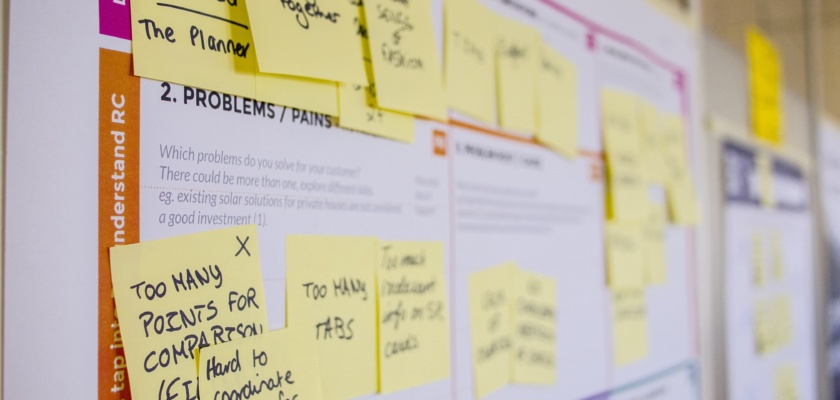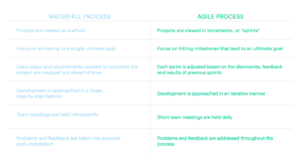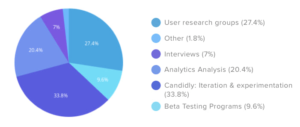Creating an Agile Product Development Process for Your Team

“Agile” is one of those words that gets thrown around so much that it sometimes loses its meaning. But there’s an important place for “agile” when it comes to product development: it’s the model that teams who want to be more nimble and adaptive should follow.
And there’s likely a lot of product teams out there wondering how they can iterate and launch faster. According to one Gartner survey, almost half of product launches are delayed by at least a month. This creates a negative perception of the customer experience and the overall brand.
Agile teams have “the ability to create and respond to change.” Following an agile product development process helps teams create products and features faster, all without sacrificing quality.
So, how do you create an agile product development process for your team? Let’s take a look:
1. Build Teams
As with most things in business, the success of a project is greatly influenced by how well the team works together. In the product world, each person has a role to play at different stages in the product development life cycle.
Success relies on effective collaboration within and between those teams every step of the way. Essentially, each team should be able to operate and make decisions independently, like the teams at Zappos.
When building your agile product development team, remember that it needs to be cross-functional. You don’t want a team composed of people with similar skill sets and backgrounds. Instead, find a mix. Your agile product team might consist of a developer, product manager/owner, and scrum master, as well as a variety of other stakeholders.
Before you start building your teams, it’s also a good idea to consider your North Star metric so you can assemble teams around that. For example, Amplitude creates “pods” that share a common objective and measure of success. Their North Star metric is Weekly Querying Users (WQUs), which they break down into Weekly Querying Accounts and Weekly Querying Users per Account.
Encouraging relationship-building is also critical, says Jonathan Park, a senior product manager at Intuit.
“For the first few months, I focused primarily on building relationships,” Park says. “Building relationships in product management is key because you don’t have anyone directly reporting to you, yet you rely on everyone else for you to be successful. Along with getting to know people across the organization, I had to learn how Intuit worked as a whole so I could understand how I fit into the broader global org.”
2. Set Up Your Backlog
Especially in collaborative and creative environments, lots of ideas never see the light of day after being tabled for a better, more viable product concept. But just because these ideas didn’t make it at the time, it doesn’t mean they’re never going to work. Sometimes it’s about waiting for the right time.
That is why it’s important to set up a backlog. Your backlog is essentially a list of ideas you haven’t built—yet. You can prioritize and categorize your backlog to make it easier to reference. Then, when you are looking for new ideas or are ready to move on to the next project, you can refer to the backlog for direction. The backlog has already prioritized the ideas so you can act quickly to implement them.
It’s a good idea to use a framework to grade and rank product concepts and ideas. This makes it easier to remain objective and empower the rest of your team to grade ideas as well. Our survey found that product managers typically prioritize ideas based on request popularity, equal compromise, ROI potential, and chronological order.
The backlog also mitigates bureaucracy and bottlenecks in your workflow.
“While it can be tempting to listen to the HiPPO (highest paid person’s opinion) in the room or even delivering the easiest-to- build feature, if your customer isn’t deriving value from it, the end result will not be optimal and your customers will let you know with their wallets,” says Nikki Hau, of Roadmunk.
“Great product experiences are built with a combination of inputs – data, gut, feedback from other stakeholders, but the most important one will always be your end customer,” Hau says.
Here’s another great resource for ideas on how to prioritize your backlog. You can then use a tool like Trello to organize all of these ideas and make them accessible to the wider team.
3. Establish Sprints
Agile product development is often compared to the waterfall method, which views projects as a single, whole entity. Agile, on the other hand, breaks projects down into sprints.
Sprints, or iterations, involve dividing a large project into multiple smaller tasks. This creates an agile environment because you can move quickly from one phase to the next, as well as revert back when needed. In software development, sprints typically last two weeks, though some operate on a one-week sprint, and other sprints last 30 days. It all depends on the project and the team.
You can also implement microsprints, which are “an iterative piece of a larger feature that can be shipped independently.” These may be shorter—a few days to a week—and are helpful for more complex and larger projects that may include several phases.
Regardless of how you break down your sprints, this allows product teams to adopt a continuous deployment mind-set, so you’re constantly iterating, learning, and launching.
You can do this with feature flags. Feature flags provide the agility needed for constant, high-quality deployment, allowing teams to instantly launch features to a subset of users and quickly address any issues before a full rollout.
4. Host Daily Scrums
Sprints are periods of focused work on a specific part of a project. Scrums are regular meetings, during which teams keep one another apprised of what’s going on in those sprints, and anything else to do with the project.
Daily scrums, or stand-ups, keep teams accountable and on the same page. Touching base often helps flag issues and bottlenecks early so you can keep the ball rolling. It also gives people a chance to ask for help if they need it. It’s important to have daily scrums, even for remote teams.
But Doodle’s 2019 State of Meetings report found that poorly organized meetings cost U.S. companies almost $400 billion in 2019. And, due to these poorly organized meetings, 44% of survey respondents didn’t have enough time to do the rest of their work.
When planning and formatting your own scrums, use and stick to an established format. Otherwise, these meetings may lose focus and end up hindering your agility rather than fueling it, not to mention waste important time your team could otherwise spend contributing to the project.
5. Test Your Product Concepts
Being agile doesn’t just mean being fast. It means being fast and adaptive. This is where testing comes into play—you want to get feedback and insights to help you evaluate your products and features before (and after) finalizing and launching.
It’s important to test quickly and often when using an agile product development strategy. It’s equally important to share test results with your team and stakeholders so they widely understand your learnings and rationale. As such, involve several members of your product team in the testing process.
Grubhub uses Taplytics to run tests and experiments and share findings across multiple teams.
“Even though we needed to make the decision to ship as fast as possible, we still used Taplytics to give us control over the feature’s distribution. For example, we would still be able to roll the feature back to say 10% and measure the impact of the release retroactively. A lot of things were happening all at once, but for everything we’re building to support these local restaurants, we want to ensure that they are sustainable. We want to make these features reusable for future feature development so we can continue building on this foundation.”
– Clara Li, a product leader on the Diner team at Grubhub
When running your own tests, it’s not enough to test on a single channel. That’s why it’s important to consider all channels and platforms, as your customers will likely use your new product or feature with a variety of devices. Brands that invest in cross-platform experiences earn up to 20% more revenue.
Booking.com uses Taplytics to run A/B tests on mobile and desktop, knowing their customers use both channels to browse and book travel with their tool. Their tests have led to conversion rates two to three times higher than the industry average.
To get started with your own multichannel A/B tests, here’s a complete guide to A/B testing for product teams.
6. Solicit Customer Feedback
Customer-led product teams know how important it is to not only hear what customers are saying but also actively build products and features that serve their underlying needs. Though tempting to overlook, it’s true in an agile environment because it allows teams to be more nimble and flag “failures” before investing too many resources into nonviable product concepts.
“When you skip this step, you sacrifice quality for speed. This will soon require a v3 of the design system you have just put in place. In the end, you will have wasted more time and money focusing on being fast and agile than you would have if you put proper user research methods in place from day 1.”
– Chelsea Oswald, Shoelace (source)
In fact, most product managers solicit feedback at every stage of the product development process—before, during, and after the build—according to our survey.
There are many ways to solicit feedback. Our survey found that the most common methods were iteration and experimentation, user research groups, and analytics analysis. You can also consider surveys, review mining, social media listening, and chatbot transcripts. When conducting analytics analysis, remember to consider both qualitative and quantitative data to get a more complete and informed view of customer needs.
Moving Forward with Agile Product Development
Your team is only as fast as the tools that empower them. Using a comprehensive and powerful platform like Taplytics gives you the information you need at the pace you need it.
Taplytics brings together digital customer journey design, optimization, and messaging in a single application. Start your free trial today, and see why brands like Grubhub, Chick-fil-A, and Major League Soccer chose Taplytics to upgrade their apps, websites, and consumer communication channels.
Design and deliver remarkable product experiences with Taplytics.




